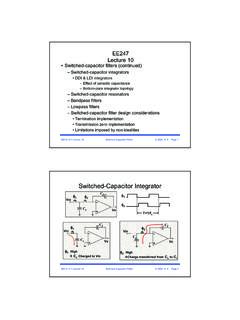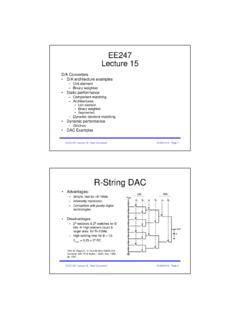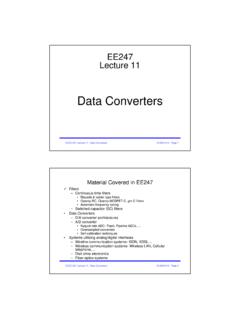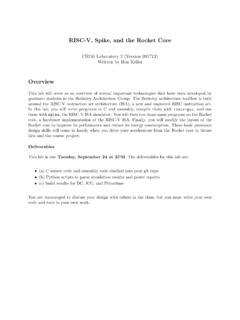Transcription of EE143 F2010 Lecture 13 Chemical Vapor …
1 Professor N Cheung, BerkeleyLecture 13EE143 F20101 Chemical Vapor Deposition (CVD)filmsubstratechemical reactionsourceMore conformal deposition vs. PVDsteptt( higher temphas higher surfacediffusion)Shown hereis 100%conformaldepositionProfessor N Cheung, BerkeleyLecture 13EE143 F20102 ZYXOHCSiOHOCS iateorthosilicenetetraethylTEOScHSiOOSiH HOPOPHSiOOPglasssilicatephosphoPSGbHSiOO SiHSiOa24522224252225222242.:)(262534.:) (2)(gas350oC-500oCsolid350oC-500oCgasLPC VD ExamplesProfessor N Cheung, BerkeleyLecture 13EE143 F20103 HFWHWFWfHSiSiHSiPolyeHNSiNHSiHNSidCo63)( 2)(123)
2 (26260042433443 Professor N Cheung, BerkeleyLecture 13EE143 F20104 CVD ReactorsProfessor N Cheung, BerkeleyLecture 13EE143 F20105 CVD Mechanismsreactant12543stagnantgas layersurfacediffusionsubstrate1 = Diffusion of reactant to surface2 = Absorption of reactant to surface3 = Chemical reaction4 = Desorption of gas by-products5 = Outdiffusion of by-product gasProfessor N Cheung, BerkeleyLecture 13EE143 F20106 Example:Poly-Si DepositionProfessor N Cheung, BerkeleyLecture 13EE143 F2010 Flux across boundaryFlux used in reactionNormalize to total pressureThickness growth velocity)CC(hFSGG1 SS2 CkF.)
3 PPPCCY2_GAS1_GASGASSPECIES_ALLGAS NFv CVD Growth Rate ModelN = atomic density of film7 Professor N Cheung, BerkeleyLecture 13EE143 F2010 Diffusion Constant in GasProof:F =n1v4-n2v4=v4( dndx)where = mean free path of gas =Ddndx D = v2 Since kTPandv T D T3/2/PPTDD2/3o Professor N Cheung, BerkeleyLecture 13EE143 F2010 Mathematical Model for CVD (Cont.) Transport parameterhG= D/D= gas diffusion constant = Do T3/2/Pressure Surface reaction parameterkS=koexp(-Ea/kT)Balancing F1=F2 Growth velocity CALL_SPECIES= concentration at top of boundary layer N =atomic density of depositedmaterial Limiting caseskS<<hGSurface Reaction limitedhG<<kSMassTransportlimitedYNC)
4 H/1k/1(1 NFvSPECIES_ALLGS 9 Professor N Cheung, BerkeleyLecture 13EE143 F201010 Deposition Rate versus Temp[log scale] Rate023TR Masstransport limitedsurface-reactionlimited1/ TlowThigh TkT/EAeR Professor N Cheung, BerkeleyLecture 13EE143 F201011 Professor N Cheung, BerkeleyLecture 13EE143 F2010 BoundaryLayer Thicknessvs. Distance21)( UxxS = viscosity,= density, U = velocity12*See handout on CVD Kinetics for derivationProfessor N Cheung, BerkeleyLecture 13EE143 F201013 Average Boundary Layerthickness < > ULL32dx)x(L1L0eRUL is called theReynoldNumber of the reactor.)
5 When Re issmall ( < 2000), gas flow is viscous. When Re is large(>2000), gas flow is turbulent which is If deposition rate is mass transfer limited,Professor N Cheung, BerkeleyLecture 13EE143 F2010 Growth Rate Dependence on Flow VelocityYNC)h/1k/1(1 NFvSPECIES_ALLGS Fixed temp T14 Professor N Cheung, BerkeleyLecture 13EE143 F201015 LPCVD Reactors(next page)Professor N Cheung, BerkeleyLecture 13EE143 F201016 Example calculation: P reduces ~1000X from 1 atmosphere to ~1 Torr Velocity of gas flow U increases ~100X due to pumpinghPDTorrTorrFromG300X310003X100100 01000X1760 ~ PD1 Uvelocity of gas flow 100XD Therefore, LPCVD is more likelyto besurface reaction limitedGas densityLPCVD: Low Pressure and high gas velocity due to pumpinghG =Professor N Cheung, BerkeleyLecture 13EE143 F201017(1)R , sincehG (2) More conformal deposition,if T is uniform(3) Inter-wafer and intra-wafer thickness uniformity less sensitiveto gas flow patterns.
6 ( wafer placement).WafertopographyLPCVD FeaturesProfessor N Cheung, BerkeleyLecture 13EE143 F201018 Gas Flow Issues(2) Mass depletion probleminoutmoreless(1) depends on gas flow pattern Furnace tubewafersProfessor N Cheung, BerkeleyLecture 13EE143 F201019(1) Temperature Ramping along reactor lengthFor reaction-limited regime:R(x) = A exp[-EA/kT] C(x) [where C(x) = SiH4 Conc.] Creating a temperature gradient of 20-40 C along thetube will give better uniformity.(2) Distributed Feed ReactorsSolutions for mass depletion problemProfessor N Cheung, BerkeleyLecture 13EE143 F201020 PECVD ReactorsProfessor N Cheung, BerkeleyLecture 13EE143 F201021 Ionized Chemical species allowsa lower processtemperature to be used.
7 Film properties ( mechanical stress) can be tailoredby controllable ion bombardment with substrate bias Enhanced CVDP rofessor N Cheung, BerkeleyLecture 13EE143 F201022 Epitaxial Growth Requires an ultra-clean Si surface prior to epi growth. Requires deposition of Si at very high temperature forperfect N Cheung, BerkeleyLecture 13EE143 F201023 Strained Si Growth by HeteroepitaxyProfessor N Cheung, BerkeleyLecture 13EE143 F201024 Self-limiting surfacereactions of suitableprecursor compoundsA and B, which formthe desired product Sin a binary reactioncycle consisting oftwo of Atomic Layer DepositionFor an extensive list of precursors,seeRitalaandLeskela,Handookof Thin FilmMaterials, , Chap 2 (2002)Professor N Cheung, BerkeleyLecture 13EE143 F201025 Timing Sequence.
8 CVD vs ALDP rofessor N Cheung, BerkeleyLecture 13EE143 F201026 Spatial ALDR eaction Chamber AReaction Chamber BThe reactor has separate zones exposing the precursors one by one to a substrate that movesunderneath the reactor. Gas bearings between the zones eliminate cross-diffusion andtherefore the need for purge steps. Half-reaction timescales are ~10 msec, enabling ultrahighdeposition rates while maintaining ALD film : PV Society, 2010 Professor N Cheung, BerkeleyLecture 13EE143 F201027 Possible Spatial ALD ConfigurationProfessor N Cheung, BerkeleyLecture 13EE143 F201028 Example.
9 ZrO2 ALDP rofessor N Cheung, BerkeleyLecture 13EE143 F201029 Step Coverage(Al2O3)Professor N Cheung, BerkeleyLecture 13EE143 F201030 SUMMARY OF THIN FILM MODULEV acuum Basics Mean Free PathandImpingement RatePlasma Basics-A plasma sheathaboveelectrodesurface which maintains a voltage drop (-10 to-1000V)forion bombardmentPVDandCVDE vaporation Vapor PressureSputtering Deposition-Sputtering Yield, Co-sputteringPVD Issues thickness uniformityacross wafer,StepCoverage( geometric shadowing , Self Shadowing)CVD Deposition Rate (hGversuskseffects)CVD Issues Conformal coverage, Mass depletionPlasma Enhanced CVD (PECVD)-qualitativeEpitaxial Growth-qualitativeAtomic Layer Deposition (ALD)-qualitativ





